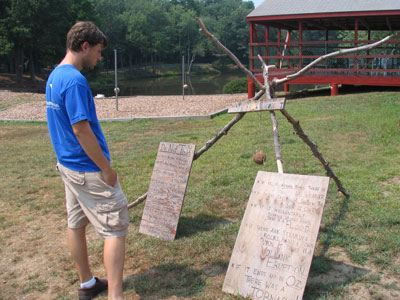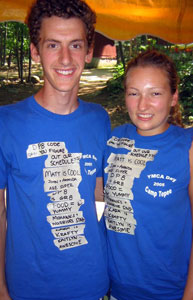 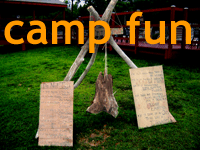 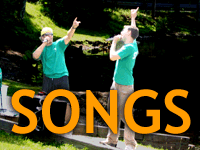 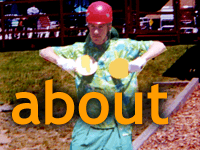   |
|
(the new) Ghoulie Games [by pete vigeant] |
|
Camp Fun = [games and activities for camps / kids / adults / everyone!] |
|
Quick Links: [games] [activities] |
|
Players: 6 - 18 There is a game named SPUD! that has blessed many playgrounds, backyards and hard tops for the last several decades (if not more) that I remember playing and losing many times as a child. The biggest problem with this game is that children have to sit down once they spell SPUD. Normally this means that the unskilled (like me) were sitting for more than half of the game. This particular version can be played with many various skill levels and age levels simultaneously without anyone having to sit out. Game Play and Setup The four bases are set up in a diamond configuration, just like in Kickball or Baseball. After playing for a while, the facilitator is encouraged to alter the configuration or base order. If working with a younger group, be sure to demonstrate the correct running order (the counter-clockwise baseball convention). I start off with a regular order then switch it up when the kids start getting too comfortable (about 10 minutes into the game). Before the game begins, every player is numbered secretly. The players are asked nicely not to share their number (although it doesn't really hurt the game if the numbers are revealed). A neat way of doing this is having the players choose from a hat - so if during the game they forget what their number is, they can check. I've also heard of facilitators writing the number on the palm of the player's hand. The goal of this game is to score as many runs as possible. Runs are scored with each successful rounding of the bases (or, depending on the base order, each time the player crosses home plate). Scores are kept individually and each player is in charge of remembering their personal run count. If working with a younger group, an extra facilitator could stand near home plate and fill in a Score Card, but normally I find that kids do a good job keeping track. Beyond that, if they forget exactly what their score is, it's better! A player is randomly chosen to be the first "IT." All they need to do is stand in the center of the diamond, throw the playground ball in the air and yell out the first number that comes to their head (that is not their number and is someone else's number). The rest of the players start at home plate and commence rounding the bases as soon as the number is called. The "IT" player first runs to home plate and then begins rounding the bases as well. NOTE: the ball has to be thrown straight up in the air. The number that is called is the number of the next "IT."
The new "IT" has the responsibility to leave their path,
grab the playground ball and yell "SPUD" at the top of their
lungs. The moment that "SPUD" is called, every player must
Freeze. If a player continues running when a loud "SPUD" is
yelled, they must go back to home plate (without scoring a
run). "SPUD" cannot be yelled if the "IT" does not have the
ball! Notes The way that I like to play is with a standard diamond configuration at first and switch to a Home, Second, First, Third configuration after about 10 or 15 minutes. Larger groups will start to complain if certain numbers are never yelled (although that makes collecting runs easier), so the facilitator should keep track and give subtle hints to the thrower. Because there is so much running, I have the kids get a drink when I feel the game has peaked and follow with a more subdued game. This way there is less comparison of scores. Teaching this in a Physical Education setting is a great way to help younger players learn about base running. Older players could keep an accurate tally of their personal score in a log and attempt to track improvement over several weeks.
Players: 10+ (the more, the better!) I was approached around February about making some sort of activity for Valentines Day. I came up with this one very quickly and assumed that the extreme difficulty would backfire. Apparently, I was *incredibly* wrong. This game encourages some bizarre team work and can be very fun to watch (especially since some players will fall in love with the challenge). Game Play and Setup Clearly define a small to medium square as the playing area. Using cones is convenient as the facilitator can alter the size to meet the needs of the game. The concept is simple: Freeze Tag meets Cupid. In a normal game of Freeze Tag, the "IT" runs around the space safely tagging all in sight. Players who are tagged are frozen until they are unfrozen by another unfrozen player. Generally this game can continue for 20 minutes or so, rotating the "IT" every couple of minutes. Cupid's variation involves a small alteration of the tag rule: Cupid must tag two (2) players simultaneously in order to freeze them. Although to the common facilitator this may seem impossible, I have seen some very determined children! An extension of the rules is either eliminating unfreezing (as this would make the game too *easy* for the players) or that a player may only be unfrozen by two (2) players removing Cupid's spell via some interesting incantation ("I hereby declare you enchantment-free!" Notes Sometimes I think this game is better as an impossible challenge - only because there are *argument causing* factors throughout. As a facilitator, I would watch very closely and assert myself as the final word in who is frozen and who isn't. Also, remind the "IT" about proper tagging techniques! Without this reminder, a viable solution would be grabbing someone smaller by the sleeve and not letting go until someone else is within hand-swipe!
Players: 16+ (I'd probably put the cap
around 40, depending on the size of the space and amount of
balls) This game goes way back in my physical education past to third grade at Stratford Academy. Ms. Mee, one of the most inspirational Phys. Ed. teachers I have ever had the opportunity to witness, allowed us to play this "treat" only on special occasions, despite year-round pleas. I still socialize with Stratford Academy friends and one fond memory is this team-friendly and skill friendly game. Game Play and Setup The boundaries of "Sink the Ship" are normally the foul lines around the basketball court. In most gyms, this means that two of the sides are larger than the other two. To make this "fair" I normally have each team switch sides every four rounds. Put all of the balls in the middle of the gym. Put the large heavy ball in the exact center (from now on I'll refer to it as the "Ship"). Divide the group into four (4) equal teams. Sometimes the teams need to be reevaluated to equalize the game, but a clever facilitator (like Ms. Mee) could motivate the game toward a tie. Each group gets one complete side of the gym. During the game, no one is allowed to cross the foul line or cross into any other team's space - regardless of whether they have / need a ball or not. This rule needs to be emphasized, as the game can cause excitement and crossing the boundaries could lead to unnecessary arguments. This game, like most, is based on a simple idea: Sink the "Ship!" This is achieved by having the "Ship" cross any of the foul lines in the gym. Of course, whichever foul line is crossed, that team is penalized by scoring a point (the lowest score *wins*). Before each
round, the balls are all put into the center of the court
and a signal is given for the players to grab a ball. Each
player may only grab one ball (unless there are more balls
than players) and cannot throw the ball until the round
begins. Once all of the balls are grabbed and the players
are back behind their lines, the round can begin. Notes I love this game. There are so many levels of micro and macro management at work during the game that teams have to learn to adjust or will not survive. Even with the strongest thrower, a poorly managed team could continuously fail. There needs to be an offense and defense, constantly working together to keep the ball supply up and the "Ship" far away. To keep one team from running away with the win, the facilitator should constantly voice the score in between rounds. A variation that I also enjoy is having only two (2) teams in charge of two of the sides. On a rainy day, this could be varied for over 30 minutes without player fatigue.
Players: 8+ (I've
played 4 on 4, but can imagine up to 10 on 10... or more!) Everyone loves "Capture the Flag." When I was really young, "Capture the Flag" meant running through the woods non-stop (sometimes late at night) with a basically unachievable goal. Sounds dangerous? Then it was revised as I got older to playing on a field - which worked much better as a game. Gyms have normally presented a challenge when adapting "Capture the Flag" mostly because of the size. This game combines two successful games ("Capture the Flag" and "Sharks and Minnows") in order to make a very entertaining and challenging gym experience for those of any age. Game Play and Setup The group needs to split into two *basically even* teams. The space is split in half and each team claims their side (the "Shark" side and the "Barracuda" side). At the back of each side, there is a safety zone from the foul line to the wall. Place one (1) ball in this safety zone for each player on the opposite team (for instance, if there are nine (9) Barracudas, then there should be nine (9) balls in the safety area behind the Sharks). The goal of the game is to either: (1) Have all of the balls in the game on a single side; or (2) Capture all of the opposing players. The
rules are fairly simple. The center line represents the
"tag" line. If a Barracuda steps onto the Shark side, then
they can be tagged and consequently go to jail. Conversely,
the same happens if a Shark crosses over to the Barracuda's
side. If a player is tagged without a ball, they must go to
the safety zone behind their opponent (the jail) - Sharks
end up behind Barracudas and vice versa. If a player is
tagged while holding a ball, they must return the ball and
return to their side before resuming play. Players who are trying to take balls may only take them from the opposing side's safety zone. Players in the safety zone CANNOT be tagged! Players can only hold one ball at a time and may not pass / kick / throw the ball at any time. If a ball is dropped, that ball must be returned to the safety area from which it was taken. Once a ball successfully crosses the halfway line, the player must bring it into their safety zone! The basic idea is that some of the players will try to steal the balls while others play defense. The jobs will change significantly as some are captured or as the loot dwindles. Notes I love introducing new games to a group of kids - especially amid yells of "Wall ball" and "Dodgeball" or other such standard games that are probably played too often by lazy instructors. When I first taught this game to a group of middle schoolers, their reaction was an expected hesitation. They left saying that it was the greatest game ever. Of course, I'll probably never play it again with them - I am fairly strict about my no-repeat attitude with groups I scarcely see - but the effectiveness with all players of varied skill levels was wonderful. In addition, the processing that the team work and strategies provide is excellent for educational facilitating.
I'm not going to lie and say this is an original idea... because it's not. I visited Camp Yaguuuuuuuuu (?) which is the oldest scout camp in the country and saw this incredibly wonderful item. There was a stump dangling from a rope on a tripod. The structure was about 4 feet tall and very eye catching, although surrounded by trees and other such nature-related colors. Leaning on the leg of the tripod was a wooden sign that read "Weather Stump" and followed with instructions on how to operate the tool. I cannot remember all of the instructions, but a simple and clear one was "If the stump is wet, it's raining." Awesome. I always wanted a weather telling device that was accurate - and as far as I can tell this stump was the most accurate thing I had ever seen. "If you cannot see the stump, it's foggy;" "If the stump is on fire, run!" And etc. Upon returning to my own camp, I decided to build my very own Weather Stump. The structure was a huge hit, although I thought we could do one better. All meteorologists know the special weather-predicting abilities of the coconut, but this important information rarely reaches the public. After consulting with many in the weather-field and attending a secret meteorological ceremony in the heart of a volcano (they don't mess around), I was told about the mysteriously wonderful properties of the coconut. The following summer, I rebuilt the weather station, this time substituting a coconut for the stump. The experiment was a complete success. Not only was the coconut more accurate, but I could tell from the amount of attention it received that everyone could tell how superior a coconut is in predicting forecasts than a stump. From Board #1: From Board #2: Of course, that was our first coconut which had limited meteorological abilities. With our expertise at choosing better weather predictors, that list will not only expand, but also be a more accurate!
One day, Bryan came to camp wearing a LiveStrong bracelet. I had never seen one, nor had many of the kids or staff. Somehow he had found out about the fund raiser directly when it started... Anyway, during our morning announcements, he showed off his new bling, referring to it as the "New Hotness." Since the bit was pretty well received and seemed fairly harmless, I started talking to everyone about the New Hotness. "Do you have the New Hotness?" This started a ridiculously popular LiveStrong fad at my camp, just months before the rest of the world became enamored with the little yellow rubber bands. Shortly after, Bryan started a New-New Hotness. He was working under the assumption that fads are short and need to be periodically replaced by something equally silly and simple. So Bryan convinced the campers to wear goggles on their heads all day. My competing Hotness, as I hated the strap digging into my ginormous head, was to wear a winter hat during the summer. Neither of these New-New Hotnesses were as successful as the LiveStrong bracelets, but they were quickly adapted and created positive murmurs throughout camp. The following years we integrated several other kinds of Hotness, all achieving some level of success.
This picture is NOT of the New Hotness, but it's still pretty darn funny. How else do you deal with campers constantly pestering you for the schedule? |
